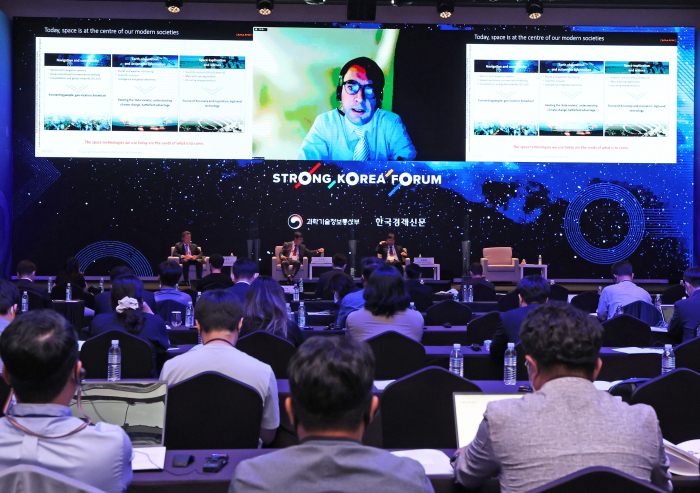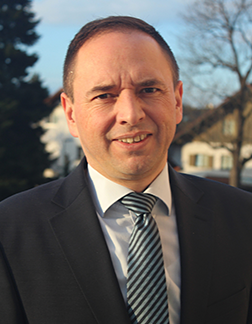Aerospace & Defense
The lunar economy is here – Airbus Vice President Jaffart
Airbus anticipates collaboration with the South Korean government on unmanned probe to the moon this year
By May 30, 2022 (Gmt+09:00)
5
Min read
Most Read
LG Chem to sell water filter business to Glenwood PE for $692 million


Kyobo Life poised to buy Japan’s SBI Group-owned savings bank


KT&G eyes overseas M&A after rejecting activist fund's offer


StockX in merger talks with Naver’s online reseller Kream


Mirae Asset to be named Korea Post’s core real estate fund operator



Global aerospace juggernaut Airbus SE says we have already entered the lunar economy and the company is looking forward to soon collaborating on lunar projects with South Korea.
"The lunar economy refers to the whole gamut of activities involved with the production, use and exchange of lunar resources on the Moon’s surface, in lunar orbit, and even on Earth.
Laurent Jaffart, Vice President of Airbus and the Head of Strategy, Corporate and New Business Development of Airbus Defense and Space had an interview with The Korea Economic Daily last week on the sidelines of this year's STRONG Korea Forum. The annual event is jointly held by the newspaper and the Ministry of Science and ICT.
Airbus is part of the Artemis program, a human spaceflight project led by the National Aeronautics and Space Administration (NASA) with multiple partners, such as the European Space Agency (ESA) and the South Korean government.
Artemis' goal is to return humans to the Moon by 2025. But instead of merely landing on the Moon as before, the program plans to conduct extensive research.

The following is an excerpt from the interview with Mr. Jaffart.
▲Airbus D&S seems to be on top of the global trend with the outstanding examples of the European Data Relay System and the European Columbus Module. What is the satellite project that the company is introducing this year?
"Thank you, the projects you mention are not the most recent ones Airbus Defense and Space launched but those are emblematic of the role we play with our institutional customers to deliver on their vision.
This year is undeniably the year of going back to the moon with the Artemis Program for which we are delivering the European Service Module, which will be attached to the capsule carrying the astronauts. We are excited to have been part of this adventure, the beginning of a new era in lunar exploration and potentially a new lunar economy.
We are also excited to see the OneWeb constellation progressively deployed and are looking forward to the full entry into service."
▲ Please introduce us how Airbus D&S differs from other space companies.
"Our Space activities revolve around 4 major pillars:
1. Secured Connectivity and future networks, we are delivering telecommunication satellites, operating them on behalf of our key home nations customers. We are delivering the Galileo second-generation navigation satellites, enabling high precision Positioning, Navigation and Timing (PNT) worldwide. We are providing the backbone of resilient communications to Earth and soon to the Moon.
2. Earth observation: Through science and actionable intelligence, we bring awareness to humanity. Awareness of what is happening on Earth, from climate to security and defense applications, but also awareness of what is happening in space, preparing for future space traffic management.
3. Exploration: Covering the 3 destinations, LEO the ISS, Moon with our participation in the Artemis program and Mars with robotics.
4. Space products: Providing differentiating spacecraft equipment internally but also to other primes independently.
We are present in several European countries, and the US with a sustainable industrial presence. We are capable of offering tailored end-to-end solutions while partnering with other companies ranging from start-ups to established players."
▲ Airbus D&S has continued its strong cooperation with South Korea; please introduce us to one of the projects that you believe is successful that is done with Korea. What were the impressions you had of Korean researchers regarding co-development?
"Airbus has a successful track record supporting Korea’s space goal, and is involved in several projects in the country ranging from equipment sales to large program deliveries.
We started supporting Korea’s space activities in the mid-1990s, first working with the Korean Aerospace and Research Institute (KARI) for the KOMPSAT-1 system design and assembly integration and test set-up, followed by the joint development of the KOMPSAT-2 platform for Earth observation.
In 2005, Airbus partnered with KARI to design and produce the GEO-KOMPSAT satellite, which was Korea’s first geo-stationary satellite.
We have also been working on the ANASIS-II programme (Army Navy Air Force Satellite Information System-II) which was launched in 2020 from Cape Canaveral in Florida. Built for South Korea, ANASIS-II provides secured communications over wide coverage. Based on the highly reliable Eurostar platform, ANASIS-II was the 52nd Eurostar E3000 satellite launched and will operate in geostationary orbit.
We are also a partner in the upcoming KOMPSAT-6 Earth observation satellite and Satellite Based Augmentation System, and are providing high-resolution satellite imagery services to various Korean operators today.
There is great potential for new space development in Korea, and it is absolutely crucial that Airbus continues to work with and rely on trusted partners that can help us develop and industrialize new technologies that are qualified for space. We are excited to continue the successful cooperation in high-performance optical and radar sensors with KARI and the national space industry.
Korean researchers are developing state of the art technologies and investing heavily in Research and Development alongside world-class manufacturing capabilities making Korean companies strong partners for a company like Airbus."
▲ What would be the obstacles in constructing a private-led ecosystem in the space industry?
"For any economy to strive, market demand needs to be strong and it’s clear that space has never been more relevant in today’s challenges -- global connectivity, climate change and security to name a few. So the demand is there. Several aspects of the space economy are already strongly influenced by private-led eco-systems, starting with the satellite telecom industry.
It's what drove us to revolutionize satellite manufacturing for constellation satellites, or invest in our own very high-resolution Earth Observation constellation, Pléiades Neo. Governments and public demand were strong drivers to transition from public demand to commercial demand. The same will take place in new domains like the lunar ecosystem. Public demand will stimulate commercial demand over time."
Write to See-Eun Lee at see@hankyung.com
Jee Abbey Lee edited this article.
More to Read
-
 Tech, Media & TelecomQuantum computing firm IonQ hit by short seller report
Tech, Media & TelecomQuantum computing firm IonQ hit by short seller reportMay 05, 2022 (Gmt+09:00)
3 Min read -
 Bio & PharmaBoryung takes 'health is wealth' to whole new level – space
Bio & PharmaBoryung takes 'health is wealth' to whole new level – spaceApr 20, 2022 (Gmt+09:00)
1 Min read -
 Aerospace & DefenseDefense giants eager to bolster satellite business
Aerospace & DefenseDefense giants eager to bolster satellite businessFeb 11, 2022 (Gmt+09:00)
4 Min read
Comment 0
LOG IN


